A Little Background
I promise I’ll get to the making of the socks after a little introductory material. After suffering through some miserable rides, I have discovered that as long as my feet and hands stay warm, the ride can be enjoyable. A big part of staying warm is keeping the hands and feet dry. Unlike hiking, when cycling it’s much harder to regulate temperature once you get wet because the wind cuts through any layers that are not wind/water proof.
There are gloves and mittens galore to keep hands dry and warm. Not so much when it comes to feet, especially when trying to go lightweight for bikepacking. Sure, a set of full booties would work. However, they are bulky and I generally don’t like riding with them.
Waterproof socks are another option that some riders prefer (Gore socks are a popular choice). I’m really picky with my socks and seams and don’t like to wear more than one sock when riding. If I could get past my personal hangups with seams and bunched up socks, I’d have a lot more cold/wet weather sock options. But I can’t.
Instead, my preference for bikepacking is to use wool socks and toe warmers. This works for temps down to the low 30s and some light precipitation. It also works for heavy rain if the temperature is fairly mild. What about those conditions that are both cold and wet? That’s where the vapor barrier idea comes into play.
What Is Vapor Barrier?
Andrew Skurka has a simple definition of a vapor barrier:
A VBL is a non-breathable material that does not permit the transmission of moisture through it.
Vapor barrier clothing isn’t a common gear choice for most people. It does have a specific application that most of us don’t run into for our “normal” trips. For detailed descriptions of vapor barriers and how to use them, please read Andrew Skurka’s post and the Stephenson’s Warmlite article.
For my Tour Divide ride, I’m using the vapor barrier concept to help keep my feet dry and warm on the rainy days and walking through the snowy passes. It’s a slightly different use of vapor barrier, but it works for me.
Designing the Socks
After researching vapor barrier socks, I found several companies that make socks ranging from $30-60. I also found a post on UltraliteSkunkWorks about making cuben fiber socks, although I still don’t know how he managed to actually get those socks on his feet. Neither of these were the ideal solution for testing – too much money or too much time to make socks. Luckily, Stephenson’s Warmlite has VBL socks made with their Fuzzy Stuff material for only $11. That was exactly what I needed for a test pair of socks.
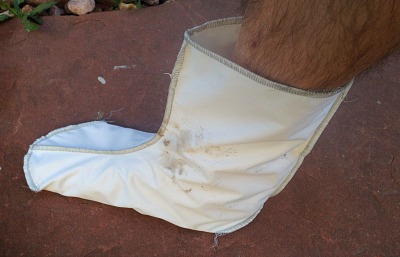
As expected, they worked as a VB sock. However, as I mentioned above, I’m a bit finicky about sock seams and the seam and the end of the toes was too much for me when wearing cycling shoes. The Stephenson’s socks would work well for hiking or maybe winter cycling when wearing shoes that don’t fit snugly.
Since the fit of the socks was good, I figured I could use that design as a template for some cuben fiber socks. The idea was to use the super thin cuben fiber material that would not cause a bulky seam at the toes. The cuben socks would be so thin, they could also be worn with normal cycling socks and not be too tight when wearing cycling shoes.
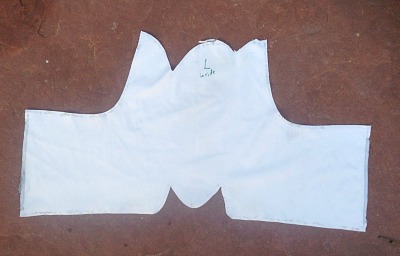
Making the Socks
I wish I could sew, but I have never taken the time to learn. Luckily for me, cuben fiber can be “taped” together and it’s super thin. Even luckier is the fact that Yama Mountain Gear sells a DIY kit for making cuben fiber stuff sacks that has enough materials to use for making socks.
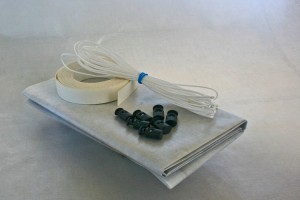
The kit could make 3 individual socks for anyone that has 3 feet. Instead, I made 2 socks and have enough left over to make 2 small stuff sacks.
Based on the fit of the Stephenson’s socks, I decided to make the cuben socks a bit more form fitting. Bad idea! I should have known better than change a working template, but I’m a bit of a slow learner. Luckily, I was able to “extend” that sock with some extra cuben material and make it fit.
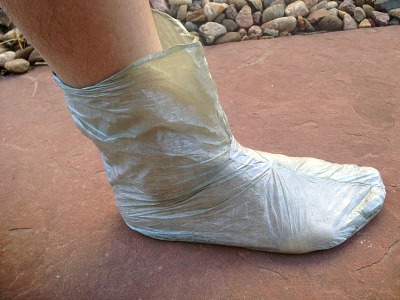
The second sock was based on the Stephenson’s template and it fit perfectly. If anything, it’s a bit too long for my foot. The good news is that the cuben can bunch up and not be bulky so it’s ok to be a bit big. Better to have a sock that’s a little long but easy to get on and off.
With my new VB cuben socks, it was time for some cold weather riding. Spring in Colorado had just what I needed. A 50 mile gravel grinder gave them a good test. That’s when I realized just how much your feet can sweat even when it’s 30 degrees outside. The socks had a puddle of sweat in them after this first ride. Yeah, I know, kind of gross.
A pool of sweat is not enough to make me give up on my idea. Since toe warmers work on the outside of cycling shoes, I decided to make VB toe warmers.
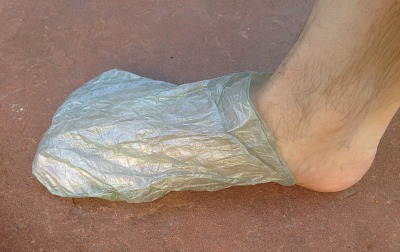
This was the right combination of vapor barrier and sweat regulation. The VB toe warmers are just enough to take the edge off of a cold light rain. For a full on rain storm or trudging through snow, the full socks would be required. Since the cuben is so thin and light, I can pack both pairs for a range of conditions.
The weight for both pairs is negligible. The more important metric is having warm and comfortable feet during cold wet weather. This one can be filed under DIY project success.
